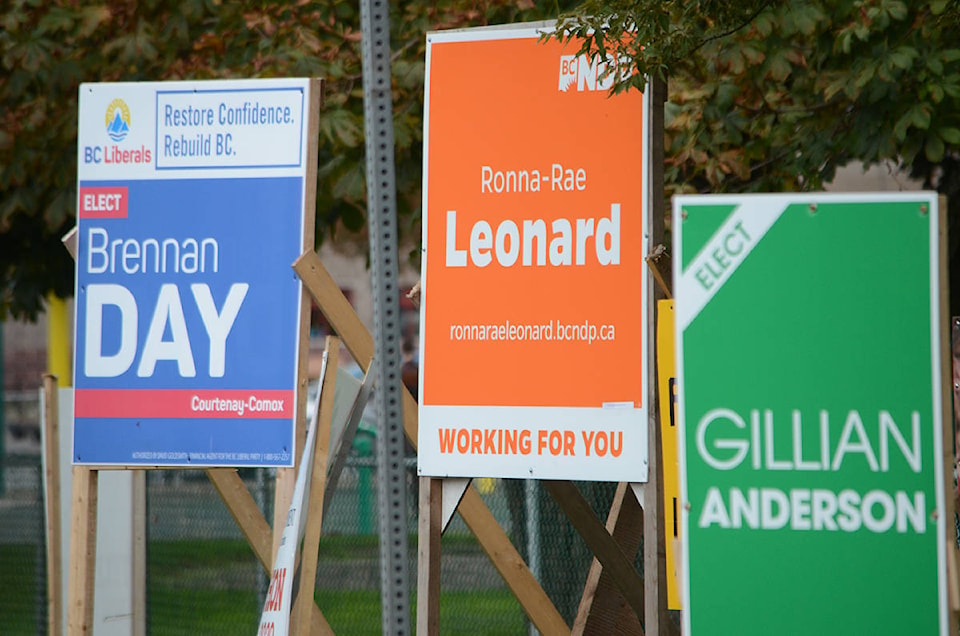In 2017, the Courtenay-Comox electoral district kept the province on edge, not only as to who would win locally but what it could mean to the parties fighting to form a government.
In a virtual photo finish on election night, the NDP’s Ronna-Rae Leonard was declared the winner by a margin of nine votes, beating out the Liberals, Greens and Conservatives. This ultimately prevented the Liberals from getting a majority and subsequently to the NDP forming a government with the Greens.
RELATED STORY: NDP Leonard declared Courtenay-Comox winner by nine-vote margin
While official results came in much later, they held up Leonard’s victory, though the final difference between her and the Liberal candidate Jim Benninger grew to 189 votes.
This time the incumbent Leonard is running against the Liberals’ Brennan Day, who ran for city council in Courtenay in 2018, and the Greens’ Gillian Anderson, who had put her name forward to be the NDP candidate against Leonard in 2017. While we might not see such razor-thin margins this time, University of Victoria professor Kimberly Speers, who teaches in the School of Public Administration, spoke to Black Press, saying she expects Courtenay-Comox to prove to be one of the more interesting races on Vancouver Island in 2020, perhaps along with Parksville-Qualicum, where Michelle Stilwell ended up as the only Liberal MLA from the Island last time.
There are a few other places to watch on the Island, such as Cowichan Valley, where the Liberals and NDP are trying to unseat Green leader Sonia Furstenau. Speers also cites races such as Saanich North and the Islands. As to whether there will be an “orange crush” on the Island, she does not expect so.
“I think we’re still going to see a red spot and two green spots,” she says.
Some of the key concerns could be whether voters get behind John Horgan as “caretaker” during the pandemic and the subsequent economic upheaval.
“I think people are looking for some type of stability at this point, given everything that’s going on,” Speers says.
There is question of whether the Greens could add votes, particularly from the NDP, in light of Anderson’s past with the party, and whether the absence of a B.C. Conservative Party candidate could boost Day and the Liberals. The polls do indicate strong support for Horgan and the NDP in the province, so Speers won’t be surprised by an NDP win in Courtenay-Comox, “despite some strong contenders.”
There are things to watch for though during the final days of the campaign, Speers says, such as whether party leaders make appearances in areas where the vote could be close, like Courtenay-Comox.
Province-wide, the NDP is holding a significant lead in most polls, and Speers isn’t anticipating as close a race as in 2017.
“I don’t think it’s going to be kind of that nail-biter … that we saw in 2017,” she says, and she thinks it could prove frustrating for voters if the province ends up with a minority government again.
Still, Speers concedes nothing is certain until the votes are counted. There are questions around voter turnout, though she points out last month’s election in New Brunswick posted similar voting numbers to the previous contest.
“I think with this election, there’s a lot of unknowns,” she says.
While there is talk about delays in knowing the final tally for the Oct. 24 election, Speers said the New Brunswick election was able to come up with decisive numbers quickly, even with a high number of mail-in ballots.
“They managed to announce a winner that night,” she says.
At the local level, one factor missing this time compared with previous votes is the informal polling parties conduct through door-to-door canvassing.
“That is just a vital part of knowing how they’re doing,” she says.
Online forums might be able to give some indication, but there is something missing for local candidates when they cannot meet voters face to face, especially in light of how easily party members can pose as undecided voters online. As it stands, the parties might have to rely on data from previous elections, but the influx of new residents in areas with close races like Courtenay-Comox does pose questions.
“There’s so many ifs, ands or buts here,” she says.
mike.chouinard@comoxvalleyrecord.com
Like us on Facebook and follow us on Twitter.
